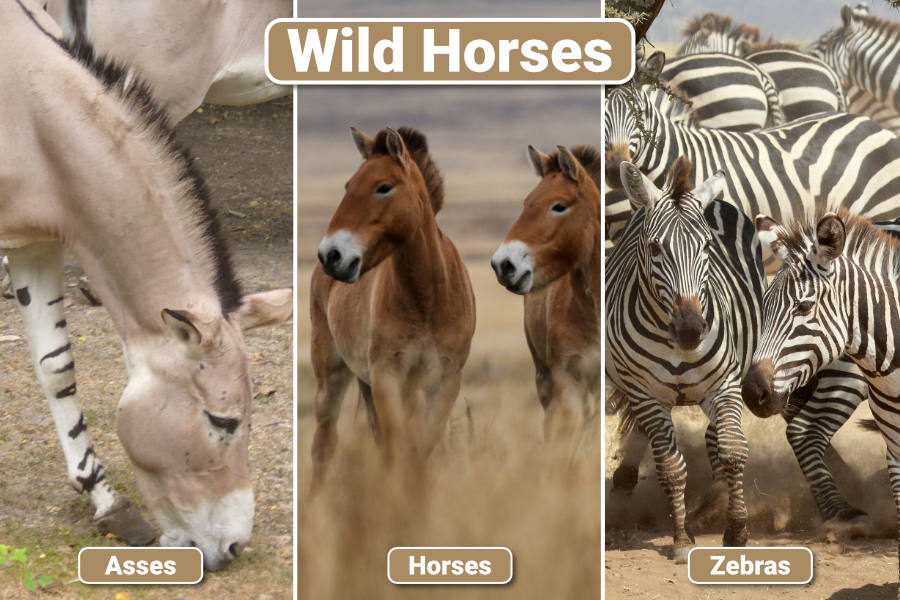Wild horses are members of the horse family Equidae that have not been domesticated. The term is also used to describe feral horses – animals that live in the wild, but which are descended from domestic horses.
On this page is a list of all living horses, asses / donkeys and zebras. The list includes wild horses, together with domestic species such as the domestic horse and donkey.
Page Index
The Horse Family & Different Types Of Horses
The horse family, scientific name Equidae, is home to the world’s horses, asses / donkeys and zebras. All living members of this family belong both to the subfamily Equinae, and to the genus Equus.
- Members of the subfamily Equinae (which contains all living horses, asses and zebras) are known as “equines”.
The first horses appeared around 55 million years ago during the Eocene Epoch in North America, and were small, multi-toed forest dwellers such as Eohippus.
Over millions of years, horses evolved into the large, single-toed, cursorial (adapted for running) animals that we know today.
Horses were first domesticated approximately 6,000 years ago in the steppes of Eurasia, near present-day Ukraine, southwest Russia, and west Kazakhstan.
Horse Vs Donkey Vs Zebra
Horses, asses, and zebras are all members of the Equidae family but differ in habitat, behavior, and physical traits.
- Horses are widely domesticated for riding and work. They evolved in open plains and have long legs for running fast. Their coats are more waterproof than those of donkeys, and their tails are more flowing.
- Asses, including the domestic donkey, are adapted for arid environments, and are known for their endurance and braying calls. Their long ears help with temperature regulation in hot, dry climates. Asses are classified in the subgenus Asinus.
- Zebras, exclusive to Africa, are all wild, with distinctive black-and-white stripes for camouflage and herd protection. Zebras are classified in the subgenus Hippotigris.
List Of Horse Species, Including Wild And Domestic Species
African Wild Ass
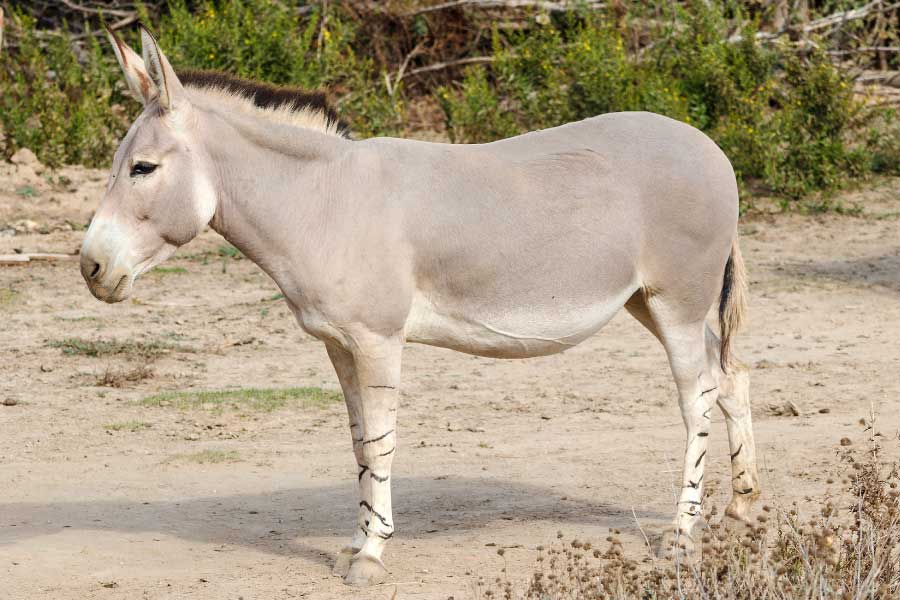
- Scientific name: Equus africanus
- Where found: Native to the Horn of Africa, primarily found in Eritrea, Ethiopia, and Somalia. Small populations may exist in Sudan.
- IUCN conservation status: Critically Endangered
The African wild ass is a hardy, desert-dwelling equid native to the Horn of Africa. Characterized by its pale coat and distinctive horizontal stripes on its legs, it has a stocky build and short, bristly mane.
The species is believed to the be the wild ancestor of the domestic donkey, and is considered by some authorities to be the same species (Equus asinus).
Due to habitat loss, hunting, and competition with livestock for resources, the African wild ass is critically endangered.
Domestic Donkey
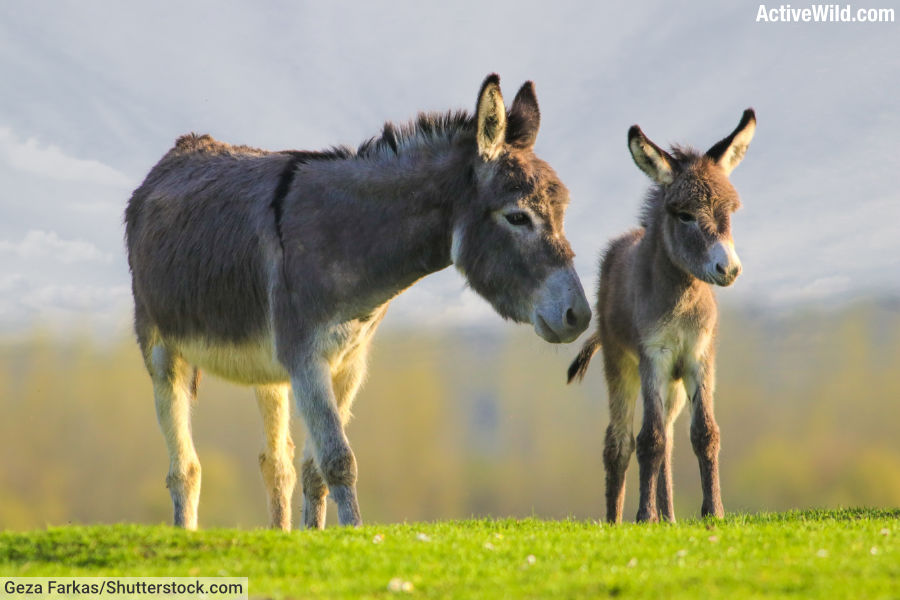
- Scientific name: Equus asinus
- Where found: Domestic donkeys are found worldwide. Originally domesticated in Africa, their presence now spans across all continents except Antarctica, adapted to various environments from rural areas to deserts.
- IUCN conservation status: Not Applicable (NA)
Domestic donkeys, descended from African wild asses, have served humans for thousands of years as working animals.
Known for their intelligence and endurance, donkeys are used for tasks such as carrying loads and pulling carts. Donkeys come in different sizes and coat colors and are valued for their adaptability to harsh environments.
You can find out more about donkeys on this page: Donkey Facts
Kiang
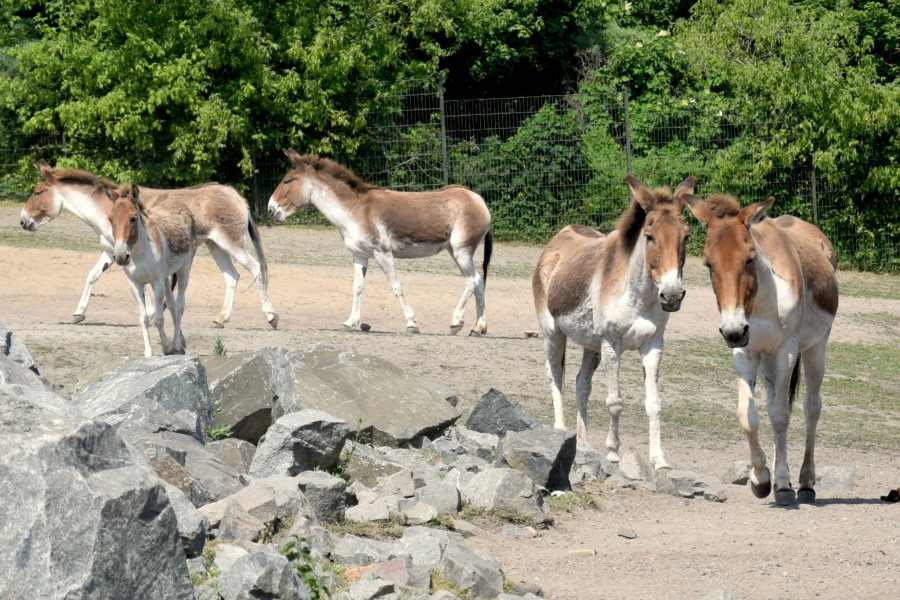
- Scientific name: Equus kiang
- Where found: The Kiang inhabits the Tibetan Plateau, and can be found in parts of China, India, Nepal, and possibly Bhutan.
- IUCN conservation status: Least Concern
The Kiang, also known as the Tibetan wild ass, inhabits the Tibetan Plateau and surrounding regions. It is closely related to the onager (some consider them to be subspecies of the same species).
With a sturdy build and a shaggy, dun-colored coat, the kiang is adapted to high altitudes and cold climates.
Kiangs primarily feed on grasses and other vegetation, forming small herds for protection against predators including wolves and snow leopards.
Onager
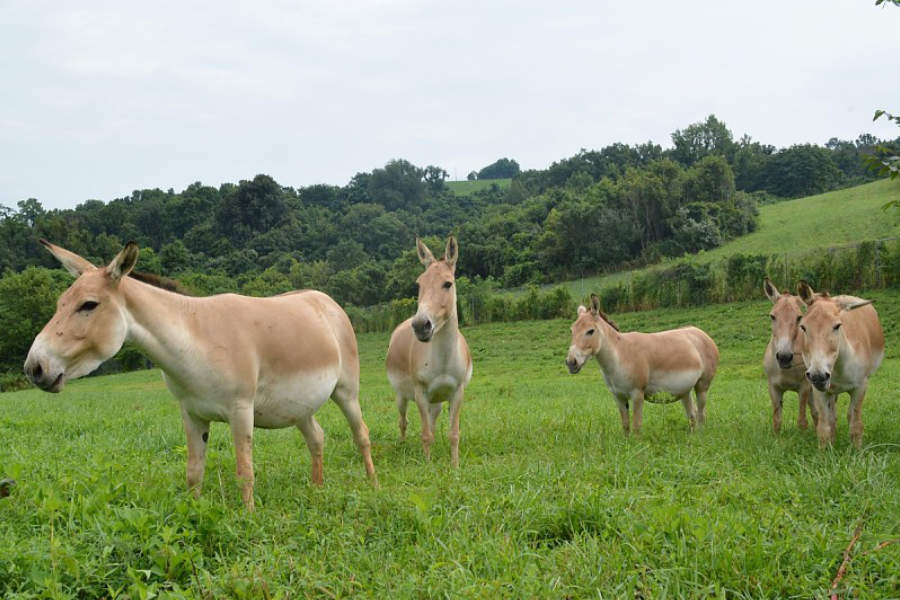
- Scientific name: Equus hemionus
- Where found: Onagers are native to several regions including the Middle East and parts of Asia, particularly Iran, Mongolia, India, and China.
- IUCN conservation status: Near Threatened
The onager, native to the deserts of Iran and neighboring regions, is a wild relative of the domestic donkey. It is also known as the hemione or Asiatic wild ass. The species is known for its reddish-brown coat and distinctive white belly.
Onagers are adapted to arid environments and can survive on sparse vegetation. Like many wild equids, they face threats from habitat destruction and hunting.
Domestic Horse

- Scientific name: Equus caballus / Equus ferus caballus
- Where found: Domestic horses are found worldwide. They have been introduced and adapted to a wide range of environments, from pastures and farms to wild populations in certain areas like the American West and Australian Outback.
- IUCN conservation status: Not Applicable (NA)
The domestic horse has been a vital companion to humans for thousands of years, serving in transportation, agriculture, sport, and companionship roles.
With hundreds of breeds developed worldwide, domestic horses vary widely in size, color, and temperament. They are highly trainable and form strong bonds with humans.
A pony is one of several horse breeds that are typically of a smaller size than other horse breeds.
The domestic horse is considered by some to be a separate species (Equus caballus), and by others to be a subspecies of wild horse (Equus ferus caballus).
Przewalski’s Horse

- Scientific name: Equus przewalskii / Equus ferus przewalskii
- Where found: Originally native to the steppes of Central Asia, specifically Mongolia. Reintroduction efforts have occurred in Mongolia, Kazakhstan, and China.
- IUCN conservation status: Endangered
Przewalski’s horse, also known as the Mongolian wild horse or takhi, is the only truly wild horse species surviving today. Native to the steppes of central Asia, it is smaller and stockier than domestic horses, with a dun-colored coat and a short, upright mane.
Przewalski’s horse is considered by some to be a subspecies of wild horse (Equus ferus przewalskii) rather than a separate species.
Once extinct in the wild, conservation efforts have led to the reintroduction of Przewalski’s horses in their native habitat.
You can find out more about Przewalski’s horse on this page: Przewalski’s Horse Facts
Wild Horses
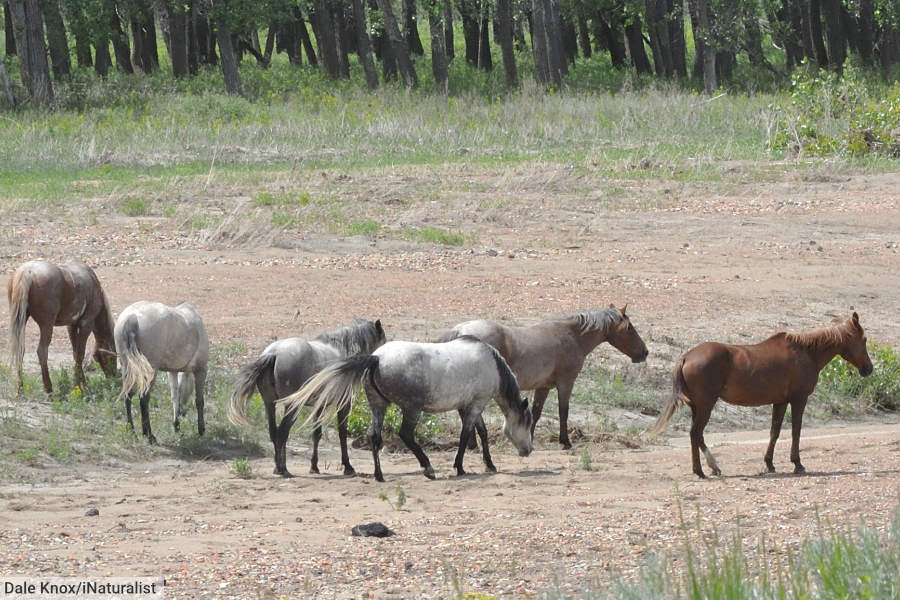
- Where found: various locations worldwide
- IUCN conservation status: Not Applicable (NA)
Wild horses such as the mustang of North America and the brumble of Australia are feral, rather than truly wild, as they are descended from domesticated horses.
Wild horse populations exist in various regions worldwide, including the American West, Australia, and parts of Europe. While often romanticized, wild horse populations can pose ecological challenges when they exceed sustainable numbers, leading to conflicts over land use and management.
Examples Of Wild Horses
- Mustangs, descendants of Spanish horses, roam the Western United States, embodying the spirit of freedom and the American West. They are known for their resilience and adaptability to harsh environments.
- Brumbies trace back to horses introduced by European settlers to Australia in the late 18th century. These feral horses have adapted to various Australian landscapes, from alpine regions to tropical forests.
- The Chincoteague pony is a breed of horse found on the Assateague Island of the eastern United States coast, known for its small stature, hardiness, and distinctive physical traits such as a broad forehead and short back. During an annual Pony Penning event, these ponies are rounded up and swum across a channel to Chincoteague Island for auction, a tradition that helps manage the herd size and supports the local volunteer fire department.
- Burros are feral donkeys found in the southwestern United States. Their ancestors were introduced to the Americas by Spanish settlers in the 16th Century.
Grévy’s Zebra

- Scientific name: Equus grevyi
- Where found: Primarily found in Kenya and Ethiopia, in habitats ranging from semi-arid grasslands to savannahs.
- IUCN conservation status: Endangered
Grévy’s zebra, named in 1882 after then-French president Jules Grévy, is the most endangered species of zebra and the largest of all wild horse species.
Found in arid regions of East Africa, Grévy’s zebra has narrow stripes and a white belly. Unlike other zebras, it lives in small, temporary groups and has different social behaviors.
Threats to the species’ survival includes habitat loss, competition with livestock, and poaching for its skins.
You can find out more about zebras on this page: Zebra Facts
Mountain Zebra

- Scientific name: Equus zebra
- Where found: This species is divided into two subspecies: the Cape Mountain Zebra (Equus zebra zebra) found in South Africa, and the Hartmann’s Mountain Zebra (Equus zebra hartmannae) found in Angola and Namibia.
- IUCN conservation status: Vulnerable
The mountain zebra, native to southern Africa, is adapted to rugged terrain and is found in rocky, hilly and mountainous habitats. It is primarily a grazer, feeding on tough grasses and shrubs. Its stripes are narrower than the more common plains zebra.
Two subspecies, the Cape mountain zebra and the Hartmann’s mountain zebra, inhabit different regions of Namibia and South Africa. Some consider them to be separate species.
Conservation efforts have helped stabilize their populations, although they remain vulnerable to habitat fragmentation and poaching.
You can find out more about zebras on this page: Zebra Facts
Plains Zebra

- Scientific name: Equus quagga
- Where found: Widely distributed across Eastern and Southern Africa, inhabiting grasslands, savannas, woodlands, and mountainous areas in countries like Kenya, Tanzania, Uganda, Rwanda, Ethiopia, Namibia, Angola, and South Africa.
- IUCN conservation status: Near Threatened
The Plains Zebra is the most common and geographically widespread species of zebra, and is one of the world’s best-known animals.
A zebra’s black-and-white striped pattern, which varies among individuals, is thought to serve various functions, including camouflage, temperature regulation, and social bonding.
Zebras are highly-social animals, forming hierarchically structured family groups led by a stallion. Plains zebras are primarily grazers, feeding on a wide variety of grasses, which helps them thrive in different habitats across East and Southern Africa.
Despite their adaptability, Plains Zebras face threats from habitat loss, competition with livestock, and hunting, emphasizing the need for continued conservation efforts.
You can find out more about the plains zebra on this page: Plains Zebra Facts
Horse Hybrids – Mules & Hinnys
- A mule is the offspring of a male donkey (jack) and a female horse (mare), known for its strength, durability, and patient temperament.
- A hinny is the offspring of a female donkey (jenny) and a male horse (stallion), less common than mules and typically smaller.
Animals Related To Horses
The animals most closely-related to horses are tapirs (family Tapiridae) and rhinoceroses (family Rhinocerotidae). These three families together form the order Perissodactyla, also known as odd-toed ungulates. This group is characterized by having an odd number of toes on each foot and a similar digestive system.
Notes On The List Of Horses
As of March 2024, when this article was written, the Catalogue of Life and the Mammal Species of the World databases disagree over the exact number of living horse species. (The Catalogue of Life lists twelve species; Mammal Species of the World lists eight species.) This is because, in some instances, a particular type of horse can be viewed either as a subspecies of another type of horse, or as a separate species.
The list above includes every species from the Mammal Species of the World list, together with additional, notable, species listed in the Catalogue of Life.

